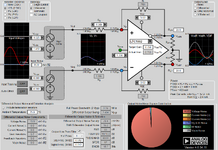digitalcat
Newbie level 5
Good Morning everyone.
I wanna show you a design i'm working on to acquire an analog single ended signal coming from an hall sensor.
Requirements i had from customer were:
I need to match the single ended output from hall sensors to the ADC input, trying to use the full range of the ADC and mantain an high resolution.
Looking around i've found a lot of interesting reference designs, in particular this from T.I (TIDA-00316).
In the tidua44a they explain the purpose of the first stage (unity gain, buffer and level shifter) for single ended ADC, but looking at the schematic i noticed also a fully differential signal conditioning thas has the same input stage, followed by a differential opAmp.

So i tried to apply this analog chain to my requirements, with two differents option for inputs: unidirectional and bidirectional current sensors, with differents sensitivities.

I am looking at my design after the first drafting, and I have some questions that buzz my head .. and I would like to share them with you to have your opinion and possibly learn something new from your suggestions.
The first question is:
The second question is:

I did two simulations with "DiffAmp calculator" from Analog Devices.
For unidirectional hall sensors (unipolar input single ended signal)) :

and for bidirectional hall sensors (bipolar input single ended signal)

Both seems to be ok for my ADC inputs.. but this comes to the third question...
The third question is specific for the ADC LTC2344-16:


Thank you all for the support.
...About the third question, in other words i wanna ask : is the Vref voltage used as reference for sampling each single diff signal (in+ and in-) or is it used just as reference for the diff signal (in+) - (in-) so i should use also the mid voltage of LTC1992 as Vocm even if it is not related to vref ?
I wanna show you a design i'm working on to acquire an analog single ended signal coming from an hall sensor.
Requirements i had from customer were:
- 0-30A unidirectional current (for dc meas., dc coupling)
- LTC2344-16 as ADC
- Flexible and "multi-purpose" design
- A lot of ADC channels, and small PCB, i decided to use only i single positive supply.
We agreed to use hall current sensors from Allegro, soic8 footprint, and use an analog signal chain that allows to mount also bipolar Hall current sensors.I need to match the single ended output from hall sensors to the ADC input, trying to use the full range of the ADC and mantain an high resolution.
Looking around i've found a lot of interesting reference designs, in particular this from T.I (TIDA-00316).
In the tidua44a they explain the purpose of the first stage (unity gain, buffer and level shifter) for single ended ADC, but looking at the schematic i noticed also a fully differential signal conditioning thas has the same input stage, followed by a differential opAmp.
So i tried to apply this analog chain to my requirements, with two differents option for inputs: unidirectional and bidirectional current sensors, with differents sensitivities.
I am looking at my design after the first drafting, and I have some questions that buzz my head .. and I would like to share them with you to have your opinion and possibly learn something new from your suggestions.
The first question is:
In my specific case, in which I have to switch from single-ended to differential signal, is the first input stage really necessary? It seems to me that with the differential amplifier I can already do all the operations I need in both cases: unipolar and bipolar, adding a vref or vibias to the signal, amplifying it or possibly attenuate it.
The second question is:
Is really usefull to add a positive bias in the input stage of the differential amplifier ?
The differential amplifier should be able to receive in its inputs both unipolar or bipolar signals, and then outputs a shifted positive differential signal adding a positive voltage to the Vocm pin.
In facts, from T.I. application report SLYT394, i saw this :
I did two simulations with "DiffAmp calculator" from Analog Devices.
For unidirectional hall sensors (unipolar input single ended signal)) :
and for bidirectional hall sensors (bipolar input single ended signal)
Both seems to be ok for my ADC inputs.. but this comes to the third question...
The third question is specific for the ADC LTC2344-16:
In my analog chain I chose to get to the entrance of the ADC with an analog range of +-2.5v but I think I had badly interpreted the datasheet of the LTC2344.
I wanna use the external Vref configuration, in order to use the 0-2.5 or +-2.5V input range, for both unidirectional or bidirectional sensors.
In configuration indicated by the arrow, it speaks of analogue range of +2.5V but in reality the "full range" can be +-5v (ie VDD).So could I also use Vref 2.5 as VOCM, as long as I stay in a 2.5V differential range?
Am i using the best configuration to optimize the accuracy of my measurements ?
Thank you all for the support.
--- Updated ---
...About the third question, in other words i wanna ask : is the Vref voltage used as reference for sampling each single diff signal (in+ and in-) or is it used just as reference for the diff signal (in+) - (in-) so i should use also the mid voltage of LTC1992 as Vocm even if it is not related to vref ?
Attachments
Last edited:
